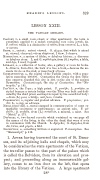Page 330 - Third Book of Reading Lessons
P. 330
.RE DING LESSONS• 329 LESSON XXIII.
THE V .TIC N LIBRARY.
CAB1I ET, n., a small room, closet, or other apartment: the term is sometimes applied to a casket containing rare coins, jewels, &c. F. cabinet, which is a diminutive of cabine, om cavanna, L., a. hole, or cavern.
ScoPE, n., extent; extent viewed. G. sl,:opos. that which is aimed at, viewed, observed,- om sk ptomai, I view, I observe.
YTHoL'ooY, n., a system of bles, or bulous history; a discourse on bulous story. L. and G. mythologia, om (G.) ythos, a ble, and lego, I read, I speak.
L1'BRARY, n., a collection of books; also, a gallery or room r books. L. libraria, om liber, the bark of a tree, a book,-because the an cients wrote on the rind, or inner bark of trees.
CoNSTANTn,dPLE, n., the capital of the Turkish empire, with a popu lation exceeding 400,000. Constantine the Great, the rst Chris tian emperor, unded thi city in 330, on the site of the ancient Byzantium. Constantinople, the city of Coustantine. See " e tropolis," p. 182.
Pm,1TIFF, n., the Pope; a high priest. F. pont e; L. pont ex, so styled because a certain bridge over the Tiber was built and dedi cated by the chief priest, aud kept in repair by the sacerdotal body: - om (L.) pons, a bridge, and jacio, I make.
PROGREss'rnN, n., regular and gradual advance. F. p1· ression; gra d1is, L., a step, an advance.
UEDAL (med'-dal), n., metal stamped in commemoration of some re markable occurrence or per rmance ; an ancient coin. F. ,e daille; S. medal/a, om (L.) etallum, a mineral, a mine. See "Metal," p. 273.
DYP1Tices, n., two-leaved records, which contained on one page all the names of the living, in the other the dead, that were of note in communion with the Church. L. diptycha; G. diptychos, om dis, twice, and ptyche, a ld.
fascRrP'TION, n., something written or engraved. F. inscription. See "Manuscript," p. 318.
1. AFTER having traversed the court of St. Dama sus, and its adjoining halls and chapels, which may be considered as the state apartments of the Vatican, the traveller passes to tpat part of the palace which is called the Belvidere, om its elevation and pros pect; and proceeding along an immeasurable gal lery, comes to an iron door on the le , that opens into the library of the Vatican. A large apartment
2s-


